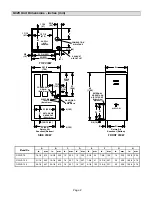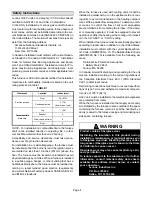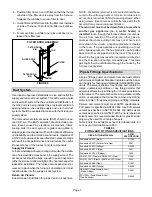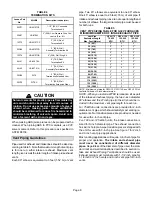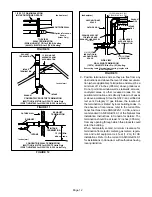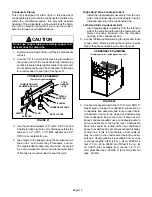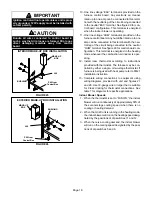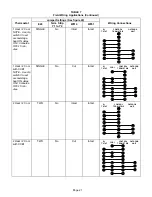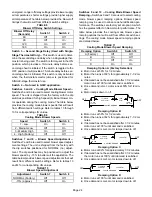
Page 10
Exhaust Piping
1 - Cement exhaust piping into flue collar socket located
on the left side of the top cap.
2 - All horizontal runs of exhaust pipe must slope back
toward the unit. A minimum of 1/4 inch (6 mm) drop
for each 12 inches (305 mm) of horizontal run is manĆ
datory for drainage. Horizontal runs of exhaust pipĆ
ing must be supported every 5 feet (1.52 m) using
hangers.
NOTE - Exhaust piping should be checked carefully
to make sure there are no sags or low spots.
NOTE - Exhaust piping must be insulated with 1/2
inch (13 mm) Armaflex or equivalent when run
through unheated space. Do not leave any area of
exhaust pipe open to outside air; exterior exhaust
must be insulated with 1/2 inch (13 mm) Armaflex or
equivalent.
CAUTION
Do not discharge exhaust into an existing stack or
stack that also serves another gas appliance. If verĆ
tical discharge through an existing unused stack is
required, insert PVC pipe inside the stack until the
end is even with the top or outlet end of the metal
stack.
CAUTION
The exhaust vent pipe operates under positive
pressure and must be completely sealed to pre-
vent leakage of combustion products into the livĆ
ing space.
Removal of Unit from Common Venting System
In the event that an existing furnace is removed from a
venting system commonly run with separate gas apĆ
pliances, the venting system may be too large to properly
vent the remaining attached appliances. The following
test should be conducted while all appliances (both in opĆ
eration and those not in operation) are connected to the
common venting system. If the venting system has been
installed improperly, corrections must be made as outĆ
lined in the previous section.
1 - Seal any unused openings in the common venting
system.
2 - Visually inspect the venting system for proper size
and horizontal pitch and determine there is no blockĆ
age or restriction, leakage, corrosion or other defiĆ
ciencies which could cause an unsafe condition.
3 - Close all building doors and windows, and all doors
between the space in which the appliances remainĆ
ing connected to the common venting system are loĆ
cated and other spaces of the building. Turn on
clothes dryers and any appliances not connected to
the common venting system. Turn on any exhaust
fans, such as range hoods and bathroom exhausts,
so they will operate at maximum speed. Do not operĆ
ate a summer exhaust fan. Close fireplace dampers.
4 - Follow the lighting instructions. Place the appliance
being inspected in operation. Adjust thermostat so
appliance will operate continuously.
5 - Test for spillage at the draft hood relief opening after
5 minutes of main burner operation. Use the flame of
match or candle, or smoke from a cigarette or cigar,
or a draft gauge.
6 - After determining that each appliance remaining
connected to the common venting system properly
vents when tested as indicated in step 3, return
doors, windows, exhaust fans, fireplace dampers
and any other gasĆburning appliance to their preĆ
vious condition of use.
7 - If improper venting is observed during any of the
above tests, the common venting system must be
corrected. The common venting system should be
resized to approach the minimum size as deterĆ
mined by using the appropriate tables in appendix G
in the current standards of the National Fuel Gas
Code ANSI Z223-1 in the USA, and the appropriate
Category 1 Natural Gas appliances venting sizing
tables in the current standard of the CAN/
CGA-B149.1 in the Natural Gas Installation Code in
Canada.
Intake and Exhaust Piping Terminations
Intake and exhaust pipes may be routed either horizontalĆ
ly through an outside wall or vertically through the roof. In
attic or closet installations, vertical termination through
the roof is preferred. Figures 8 through 20 show typical
terminations.
1 - Use recommended piping materials for both intake
and exhaust piping.
2 - Secure all joints, including drain leg, gas-tight using
approved cement.
3 - Piping diameters should be determined according
to length of pipe run. See table 5. Locate intake pipĆ
ing upwind (prevailing wind) from exhaust piping.
To avoid recirculation of exhaust gas on roof terĆ
minations, end of exhaust pipe must be higher than
intake pipe.
Exhaust and intake exits must be in same pressure
zone. Do not exit one through the roof and one on the
side. Also, do not exit the intake on one side and the
exhaust on another side of the house or structure.


